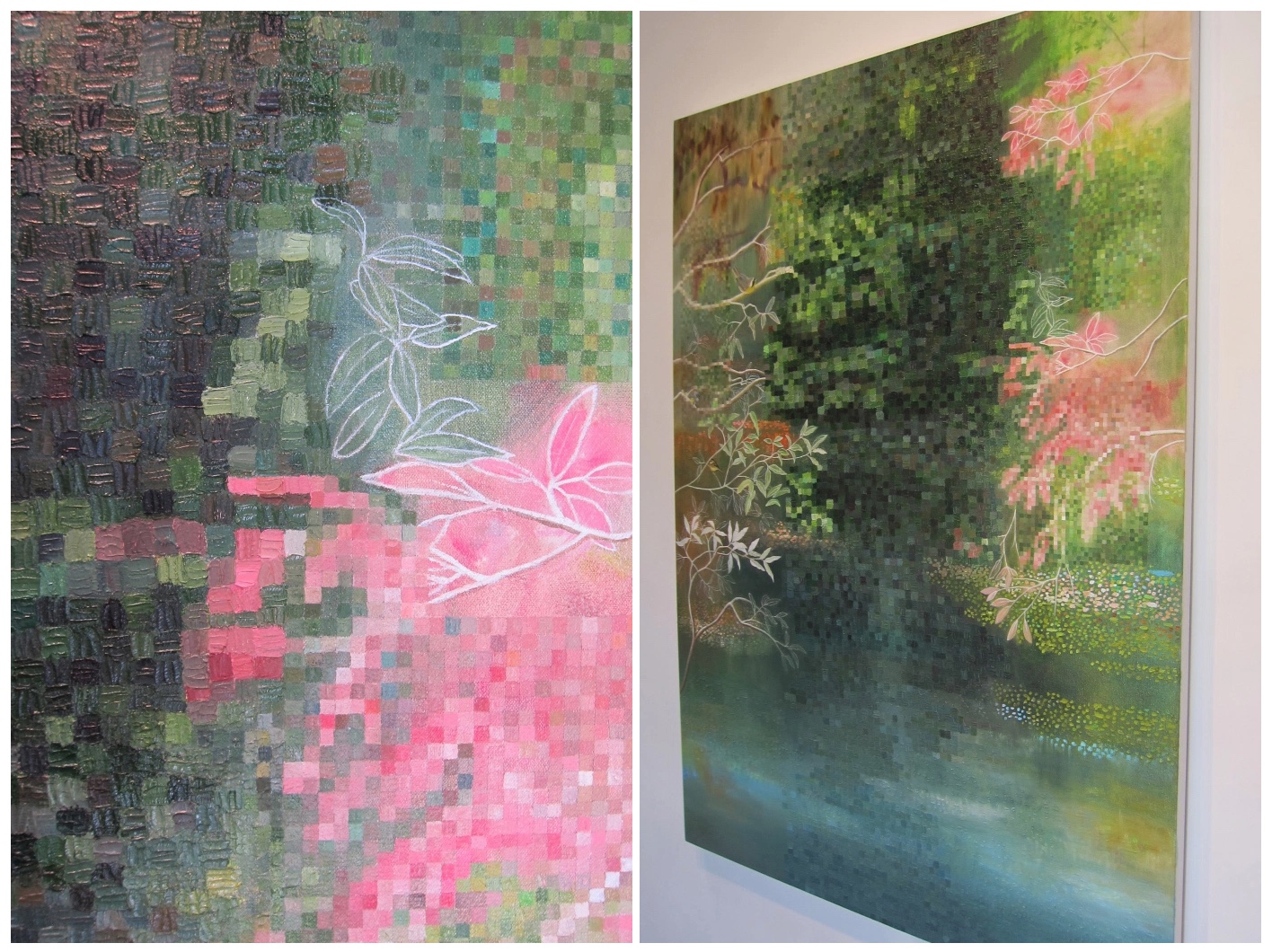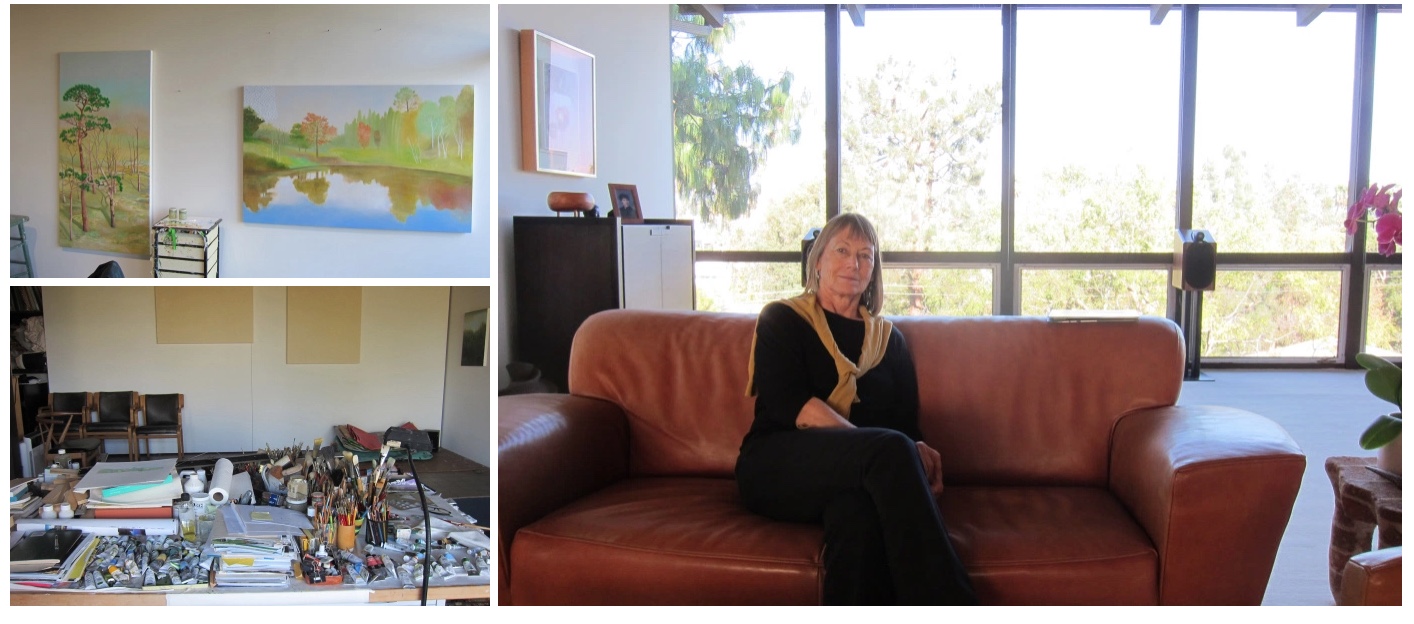Astrid Preston
ART AND CAKE
"ASTRID PRESTON; BETWEEN EARTH AND SILINCE"
Essay by Gary Brewer
Posted on December 27, 2017

Photo credit: Gary Brewer
“Nature always wears the colors of the spirit.” ~Ralph Waldo Emerson
“…like a night wind in the pines or like the sea in the dark the echo of everything that has ever been spoken still spilling its one syllable between earth and silence” ~W.S. Merwin
by Gary Brewer
When words fail us, we have images to tell our stories. It is a love poem to life to see and feel the presence of nature and to share it in brushstrokes of color guided by the pulse of our heart animating the intricately considered wonders of the world. Astrid Preston’s work revels in the spiritual beauty of nature. Her paintings whisper to the pines, caress the water, and swim through the clouds; our eyes are like a soul disembodied, we inhabit each part of the images. Pleasure becomes a profound presence; the methods and inventions in paint, of being able to capture in pigment on canvas – light, water, trees, clouds – and to poetically play with the systems of seeing. She communicates the emotions and feelings she has for nature in beautifully realized paintings, but she also playfully deconstructs the methods of visual language, exploring the minds capacity to make sense of images reduced to matter that still communicate her vision.

Photo credit: Gary Brewer
Thought, feeling, perception, consciousness – to look is to feel the visceral physicality of the world. To express feeling, the love for a thing and the love of describing it with paint on canvas, we look and see. But to capture the feeling in your gut, to express it with your heart, and to explore the life of the mind’s ability to use pigment to describe it in the myriad possibilities that oil paint grants us is ‘Art’. Astrid Preston makes images of the things she loves communicated in visual haiku, a shorthand impression of her subject. To this she adds the intellectual pleasure of deconstructing the vernacular, of ‘pixelating’ the image, and using a patchwork of physically dense squares and then inscribing four lines into the thick patches of paint in horizontal and vertical orientations. The patchwork of paint matching the colors of the scene represented deconstructs the image; delighting in our mind’s ability to still read the painting. It is an updated impressionist/pointillist approach that references digital media, but is wholly about the pleasure of paint and its protean capacity to make a readable image.
Astrid said of her work, “I have always had a difficult time communicating with words, it is still difficult for me to even write a thank you note. Painting is a way for me to express emotion; it is something I feel in the second brain in my gut. When I feel a connection to a place, it is an emotional connection. I think about my paintings as a form of Haiku, to capture an emotional impression of a time and place in a general language of color and form.”
Geometry has been an anchor for Astrid from early on in her career. In college she began as a math major and found that the logic of geometry always had a stabilizing effect on her. Later, she worked for her parents who were architects; doing architectural renderings of the homes and buildings they were designing. The patchwork grid that she employs to pixelate her current painting is a reference to the graphic symbol in architectural rendering of dirt/earth as opposed to gravel, plants or concrete.
In her early work, she would employ chromatic shifts in color within the landscape, gradient shifts in tone or color within simple abstract compositions of squares or rectangles. It was a way to ground the work and have a classical structure that kept the paintings focused and controlled. She also painted formal gardens with the strict geometries of hedges and rows giving the paintings a rigorous grounding in formal structures. Her current work has rectangular areas of physically dense patchworks of paint that are more brazen: they wink at one with the joy of a painter who has mastered her vision and is free to playfully revel in the plasticity of the medium, to explore the way one can break down the image and still capture and convey the essence of the vision. It is deconstruction as a way to show us the mechanics of perception, but not in the cold clinical grayness of academia but in the sensual and emotional pleasure of seeing,
I asked her about her use of geometry in nature, if, like Cezanne whom she loves, it was a way to bring a classical order to landscape. “In my earlier work it was a way to ground the image, it was a kind of safe place that I could feel comfortable within. Now in my pixelated patchwork of squares of paint, it has more to do with quantum physics, with the ideas about the uncertainty principle, that things are not as stable as we think, that theoretically matter can shift from one thing to another. It is a way to speak to that and it is also a way to animate the paintings.”

Photo credit: Gary Brewer
Her paintings are lush symphonic harmonies of color. The way that she renders her subjects, trees, clouds, water are with a light touch, the shapes and forms captured in a generalized way. This gives her freedom to push the color chords and their effects on spatial reading. Her works have proceeded from early paintings where she employed stricter ordering principles such as geometry, to latter works where she used deeply detailed approaches to painting, filling vast canvases with images of the forest, an immersive gestalt of the forest canopy filling the canvas from edge to edge. It is interesting to see that the geometry she employed early on to ground the work in something she knew well, is now a means to break out of the confines of strict representation; to playfully deconstruct the methods of depiction and allow the pleasure of paint as material to add a dimensionality to the work both formally and subjectively.
We spoke about these painterly patchworks of disruption within the visual field and the visual language, “In certain paintings the pixelated passages communicate the visceral physicality of the scenes with more emotional truth. When one looks at the areas where the image is painted clearly one can see and read the image easily. But when one looks at the area where the physically thick patchwork occurs it has a visual density that is more emotionally true. I think that the reflections off of the relief of the paint, the light reflecting off of the high points and the shadows that they cast, stirs something in our brains and gut that feels truer, that conveys the physically of the scene in an emotionally deeper and richer way.”
To paint is to play with the magic of consciousness. That we can make marks and represent the world about us is a miraculous representation of mind. It reflects the visual paradigms that we store in our memory that allows us to “re-cognize” the world. That we can invent new ways to communicate information, that our imaginations can change the future through language creation and chart and explore novel experiences is a form of magic.
Painting is a living medium. It is encoded with the thoughts and feelings of the artist that engages in a symbiotic relationship with the consciousness of another; it is living memory embedded in matter. Astrid Preston’s paintings connect with deep emotions and feelings in the body. There is a soulful connection to both the subject matter and the subject of painting. Her paintings revel in the living language of art, the quicksilver fluidity of language and of our constant invention of new ways to express and communicate feeling. She surrenders to the swoon of physical experience with nature and transforms it through the heart and mind into the language of Art.
Portrait of Astrid Preston (and many paintings) at her recent exhibition at the Craig Krull Gallery, Santa Monica
Represented by Craig Krull Gallery in Los Angeles


Photo credit: Gary Brewer
Works by Astrid Preston are currently on view in “Poetics of Nature”, Bakersfield Museum of Art, Bakersfield, CA, September 7, 2017 – April 14, 2018. Coming in 2018: a solo show at R.B.Stevenson Gallery in La Jolla, CA